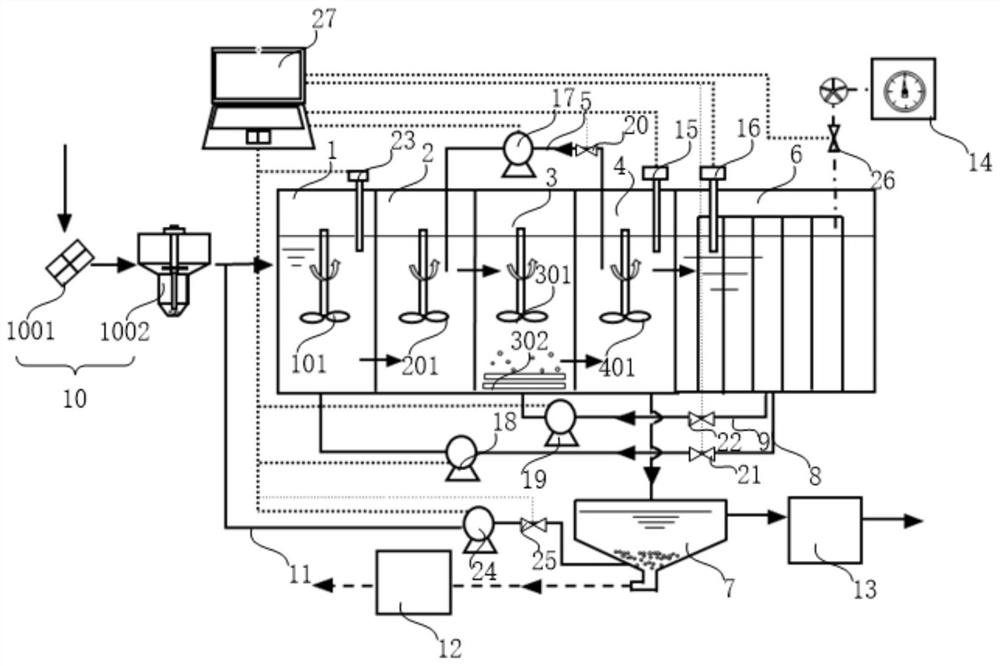Method and system for biological nitrogen and phosphorus removal of sewage
A technology for denitrification and dephosphorization and biological sewage treatment, which is applied in the field of biological denitrification and dephosphorization of sewage, and can solve the problems such as difficulty in achieving high standard discharge in sewage treatment plants, limited capacity for deep denitrification and dephosphorization, and unstable denitrification and dephosphorization process. , to achieve the effect of reducing aeration energy consumption, wide range of water quality, convenient operation and maintenance
- Summary
- Abstract
- Description
- Claims
- Application Information
AI Technical Summary
Problems solved by technology
Method used
Image
Examples
Embodiment 1
[0160] The system of the sewage biological denitrification and dephosphorization used in the embodiment is as figure 1 As shown, follow the steps below:
[0161] (1) The sewage flow is pretreated sequentially through the interception device 1001 and the sand settling device 1002, and the initial total nitrogen and total phosphorus concentrations of the sewage are measured. The total nitrogen concentration is 40 mg / L, and the total phosphorus concentration is 10 mg / L; wherein, the interception device 1001 is a grid, and the sand settling device 1002 is a swirling flow sand settling device;
[0162] (2) The pretreated sewage flows through the anaerobic device 1, the anoxic device 2, the aerobic device 3, the aerobic device 4 and the membrane-based biofilm device 6 for anaerobic treatment, anoxic treatment, and aerobic treatment in sequence. , anaerobic treatment and membrane-based biological treatment; in anaerobic treatment, the oxidation-reduction potential is -120mV, and the...
Embodiment 2
[0167] The system of the sewage biological denitrification and dephosphorization used in the embodiment is as figure 1 As shown, follow the steps below:
[0168] (1) The sewage flow is pretreated sequentially through the interception device 1001 and the sand settling device 1002, and the initial total nitrogen concentration of the measured sewage is 41 mg / L, and the total phosphorus concentration is 10 mg / L; wherein, the interception device 1001 is a grid, and the sand settling The device 1002 is a cyclone sand settling device;
[0169] (2) The pretreated sewage flows through the anaerobic device 1, the anoxic device 2, the aerobic device 3, the aerobic device 4 and the membrane-based biofilm device 6 for anaerobic treatment, anoxic treatment, and aerobic treatment in sequence. , anaerobic treatment and membrane-based biological treatment; in anaerobic treatment, the redox potential is -100mV, and the hydraulic retention time is 1h; in anoxic treatment, the dissolved oxygen c...
Embodiment 3
[0174] The system of the sewage biological denitrification and dephosphorization used in the embodiment is as figure 1 As shown, follow the steps below:
[0175] (1) The sewage flow is pretreated sequentially through the interception device 1001 and the sand settling device 1002, and the initial total nitrogen concentration of the measured sewage is 42 mg / L, and the total phosphorus concentration is 11 mg / L; wherein, the interception device 1001 is a grid, and the sand settling The device 1002 is a cyclone sand settling device;
[0176] (2) The pretreated sewage flows through the anaerobic device 1, the anoxic device 2, the aerobic device 3, the aerobic device 4 and the membrane-based biofilm device 6 for anaerobic treatment, anoxic treatment, and aerobic treatment in sequence. , anaerobic treatment and membrane-based biological treatment; in anaerobic treatment, the oxidation-reduction potential is -150mV, and the hydraulic retention time is 1.5h; in anoxic treatment, the di...
PUM
 Login to View More
Login to View More Abstract
Description
Claims
Application Information
 Login to View More
Login to View More - R&D
- Intellectual Property
- Life Sciences
- Materials
- Tech Scout
- Unparalleled Data Quality
- Higher Quality Content
- 60% Fewer Hallucinations
Browse by: Latest US Patents, China's latest patents, Technical Efficacy Thesaurus, Application Domain, Technology Topic, Popular Technical Reports.
© 2025 PatSnap. All rights reserved.Legal|Privacy policy|Modern Slavery Act Transparency Statement|Sitemap|About US| Contact US: help@patsnap.com

